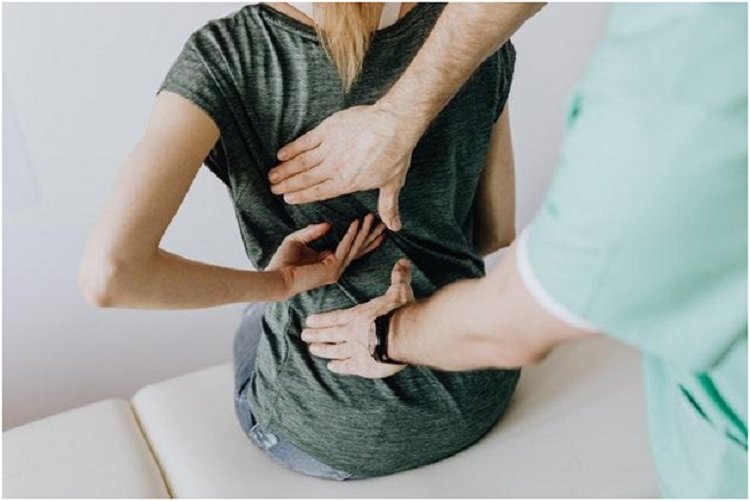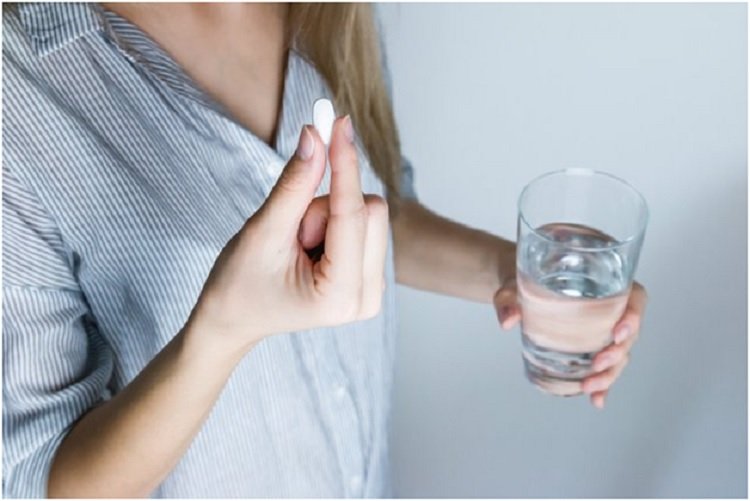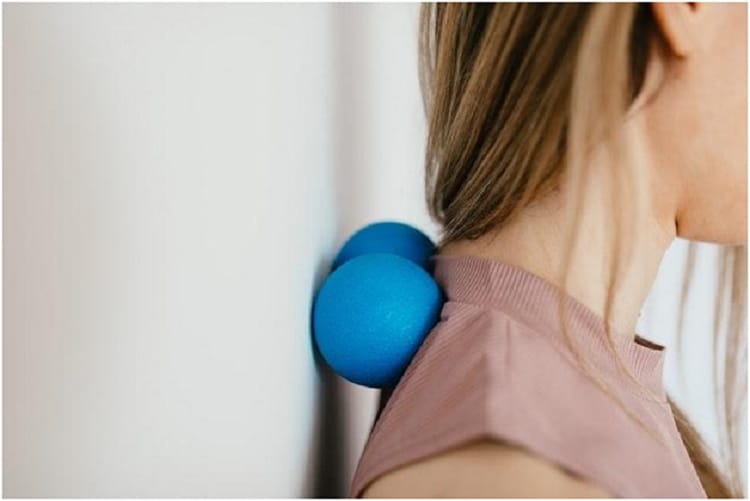Feeling pain in your upper back? You are not alone. When you feel a pain specifically in the area between your spine and your shoulder blades, it may be caused by rhomboid spasms or strains.
A rhomboid strain is a condition when the muscles on your back are stretched or torn, causing pain. On the other hand, a rhomboid spasm is a sudden, intense contraction of the rhomboid muscles that we cannot control.
The pain can be amplified as you move or breathe, and both rhomboid strain and spasm can cause swelling, bruising, and difficulty moving your shoulder blades and upper back.
A rhomboid spasm can be caused by rhomboid strain and vice versa, but each can also exist independently from each other.
Read on to learn more about rhomboid strains and spasms and how to best treat it!

What’s Causing Your Rhomboid Pain?
Typical causes for rhomboid strain including:
- Activities that overwork your rhomboid muscles, shoulders, arms, and/or back:
- Carrying a heavy backpack for a prolonged time
- Repetitive movements that utilize your arms, shoulders, or back muscles like swinging a golf club, rowing, using the fly machine, and so on
- Poor posture during sleeping, sitting, or when performing activities that use your back muscles
- Weak muscles due to the lack of exercise
- You haven’t properly warmed up before you perform sports activities described above
While the causes of rhomboid muscle spasms may include:
- Dehydration, especially during heavy activities
- Overusing the rhomboid muscle (by performing the activities discussed above)
- Staying in the same position for a long time.
Common Symptoms of Rhomboid Strain
Here are the typical symptoms for rhomboid muscle strain and spasms:
- Pain between your spine and the edge of your shoulder blades that might be amplified with movement. In severe cases, you might feel worse pain when deep breathing
- Palpable knots in the rhomboid muscle (a typical symptom of rhomboid spasm)
- Mild to severe tightness/tenderness in the upper back area
- Grinding or popping noise as you move or rotate the shoulder blade
- The difficulty of movement when moving your shoulder blades and neck
How Does It Get Diagnosed?

The main way to diagnose rhomboid muscle strain or spasm is to check for tenderness or tightness in your upper back and shoulder muscles.
Your doctor may check your medical history and/or ask for details related to any previous injuries to your back or shoulder (if any).
Your doctor might also ask you to move your arms and shoulders in particular directions to check for any movement limitations and whether your movements cause pain.
How To Treat Rhomboid Strain
There are several light exercises and stretches that can help relieve rhomboid strain, spasm, or any muscle pain in the upper back area.
Typically, to relieve the pain from rhomboid strain/spasm, over-the-counter pain medication like Tylenol (acetaminophen) or ibuprofen may be prescribed by your doctor.
You may also be given anti-inflammatory medication (typically non-steroidal) like ibuprofen, aspirin, or naproxen.
In the case of severe pain, your doctor might prescribe a stronger painkiller.

Non-Surgical Treatment Options
Rhomboid strain and spasm can be treated non-surgically.
The first thing to do when you have rhomboid strain is to stop any activity that might cause the condition, like fixing your sitting/sleeping posture and stopping the strenuous physical/sports activities that might cause the pain.
Rest your muscles and give them enough time to heal. You should also ask your doctor when it’s safe for you to resume the activities.
In the meantime, you can try out these at-home remedies to relieve the pain:
- Icing the area. Place an ice pack on your muscles for 15 to 20 minutes at a time, every 2 to 3 hours. You can use an ice pack as soon as possible after the injury to help relieve inflammation and numbs the pain.
- Using a heating pad. After a couple of days, if you still feel pain/tightness in your muscle or if you are still experiencing rhomboid spasm, you can put a heating pad (or warm cloth) for 15 to 20 minutes at a time to help ease your muscles.
- Massages are also very helpful. You can either massage the muscles yourself (or ask the help of a professional therapist) or use various tools to do self-massage at home.
You should take the medication during this recovery period as prescribed by your doctor.
Recovery times would depend on the individual and/or the severity of the injury, but the sooner you start treatment, the shorter the recovery time will be.
Treatment With Physical/ Stretching Exercises
An important thing to consider is that you should not force yourself to perform these exercises during severe pain or strain.
You might want to have enough rest first before you begin these exercises. Starting too soon might worsen your muscle injury instead.
Here are some of the simple and recommended exercises you can do at home to help relieve the pain from rhomboid strain and improve your recovery:
Rhomboid Stretch
- Stretch your arms in front of you, one hand on top of the other
- Extend your arms out in front of you, and slowly reach forward. By now you should feel a gentle stretch between your shoulder blades.
- Tilt your head forward and hold the stretch for 20 to 30 seconds.
- Repeat this movement three times. Be careful and gentle throughout the whole movement.
Shoulder Blade Squeeze
- Stand (or sit) with your arms alongside your body, maintain a straight but relaxed posture
- Draw your shoulder blades back carefully, and squeeze them together
- Hold this position for at least 5 seconds
- Bring back your shoulders to the natural position
- Relax and repeat the movement
- Continue for at least one minute
Neck Stretch
- Stand or sit in a relaxed position, keep your posture straight, and look straight ahead
- Let your head tip to one side and try to touch your shoulder with your ear (don’t move your shoulder)
- Hold the stretch for around 10 to 30 seconds
- Raise your head, then tip it to the opposite side. Hold for 10 to 30 seconds
- Repeat the entire exercise three times
Side Arm Stretch
- Bring one of your arms across the front of your body at your shoulder’s height
- Bend the other arm with the palm facing up, allowing the arm across the body to rest in the other elbow crease.
- Hold this position for 20 to 30 seconds
- Do the same movement with the other side
- Do this stretch 4 to 5 times on each side
Neck Rotations
- Sit or stand with your neck, spine, and head in your line. Keep a straight but relaxed posture
- Slowly turn your head to one side while exhaling your breath, go as far as you can without straining your neck’s muscles
- Take a deep breath and hold this position for 20 to 30 seconds
- Inhale, and return to the starting position carefully
- Repeat on the opposite side, and do this exercise three times on each side
You can also do other neck and shoulder stretches for neck pain and stiff shoulders to relieve your pain and speed up your recovery.

Consult A Back Pain Specialists For The Best Treatment Plan
Rhomboid strain and spasm can be very painful back conditions and might lead to more serious back injuries and inflammations.
It’s important to maintain the following best practices to prevent rhomboid muscle pain from happening:
- Use proper technique when playing sports
- Maintain a good posture while sitting, standing, and walking. You can use various back extension exercises to help fix your posture
- Always warm-up before any sports activities and cool down afterward
- Maintain a healthy weight
- Don’t carry heavy backpacks too often, and make sure to use both shoulders, not one
- Take frequent breaks from activities when you feel tired not to overwork your rhomboid muscles
If you experience rhomboid strain regularly, you may also want to get the help of a personal trainer that can help you correct your posture and imbalances in your body. Regular massages can also help in preventing future rhomboid strains and spasms.
It’s very important to visit a doctor as soon as possible to prevent further injuries. The sooner you start your treatment, the faster the recovery for the rhomboid muscle pain will be.
VISP of Prescott, Arizona offers an array of therapies to treat rhomboid strain, sprain, and spasms, as well as various other chronic and severe back pain.
Our team of experienced physicians and pain specialists are ready to help you with the best possible option in treating your rhomboid muscle pain, as well as the underlying cause (if any).
Don’t hesitate to give us a call immediately, especially when you experience intense rhomboid pain that worsens or doesn’t respond to over-the-counter treatment.
Short Bio for Dana Munoz:
 Dana Munoz is the content manager of Vascular & Interventional Specialists(VISP) of Prescott, Arizona, a group of subspecialty radiologists that perform numerous minimally-invasive, low-risk procedures to improve the quality of life of their patients through proven and effective therapies
Dana Munoz is the content manager of Vascular & Interventional Specialists(VISP) of Prescott, Arizona, a group of subspecialty radiologists that perform numerous minimally-invasive, low-risk procedures to improve the quality of life of their patients through proven and effective therapies

